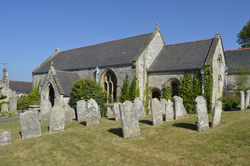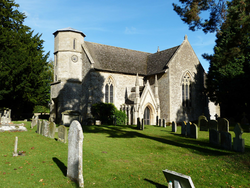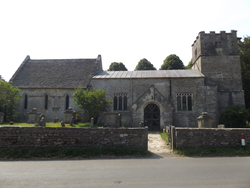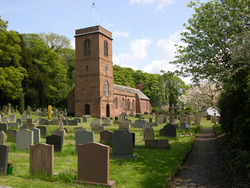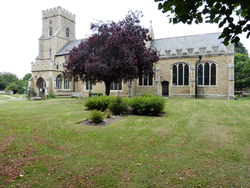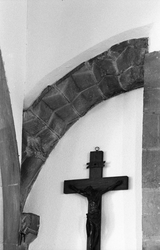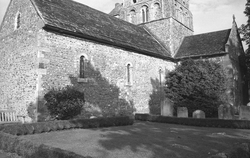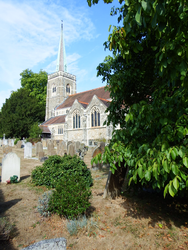
The Corpus of ROMANESQUE SCULPTURE in Britain & Ireland

St Nicolas (now)
Parish church
The present building consists of a chancel rebuilt in neo-Norman style in 1874; a S aisle to chancel built 1902; a nave, rebuilt c.1834; a S aisle to nave and S porch of 1902, and a N aisle of 1815.
The re-used nave S door and the font are all that survive of the 12thc church.
Parish church
Fyfield is a village in that part of the county that passed to Oxfordshire in 1974, and is 4 miles W of Abingdon on the N side of the A420. The church and manor house are in the village centre. The church has a nave with a Perpendicular N arcade, a large two-bay 14thc. chancel and a W turret, square in its lower stage and octagonal above. The S porch, described by Pevsner as comical, is probably J. C. Buckler's work of 1867–68. There was a fire in 1893, and after this a through restoration including the upper parts of the tower. The blocked N doorway is of c.1200 or slightly earlier. The W doorway is, stylistically at least, significantly later and is not included here.
Parish church
The Cotswold village of Cherington lies 4 miles NE of Tetbury. The church, which is built of rubble and ashlar, has a 13thc chancel, nave with N porch and S transept and a W tower. The surviving 12thc elements consist of the font, a piscina and a tympanum above the N doorway.
Parish church
Burton is a large village at the S end of the Wirral peninsula, 7 miles NW of Chester. It is built along minor roads to the W of the main A540 road that links Chester to Heswall and Hoylake. As a picturesque village within reach of Liverpool, Birkenhead and Chester its properties are highly sought-after, and it has been ranked eighth in a recent market-research survey of super-rich communities, with millionaires making up 16% of its population. St Nicholas’s church stands in an elevated position overlooking the village centre, and consists of a W tower with a porch, and a four-bay nave that is continuous with a two-bay chancel, with no chancel arch dividing the two. On the N is an aisle and this continues alongside the chancel as the Massey Chapel. Construction is of red sandstone with grey slate roofs. The church is largely of 1721, although there are Norman remains in the form of loose stones described below.
Parish church
Witham is a town in the Braintree district of E Essex, on the Roman road from Colchester, 13 miles to the NE, to Chelmsford, 8 miles SW. The old settlement is in the area of Chipping Hill, on the N side of the modern town, and it is here that the church is found. Most of Witham is taken up by the three large council estates that were built in the 1960s and ‘70s on the N, W and S sides of the old centre to accommodate families from London to move to as part of the Expanded Town overspill policy of that period.
The church is a large one consisting of a clerestoried nave with 4-bay aisles and a S porch, a chancel with a N vestry and a S chapel, and a W tower. The church is of the early 14thc, except for the 15thc chapel and late-14thc vestry and porch. The feature described here is the S doorway, which must have been incorporated from an earlier phase of the building. It is certainly 13thc but is included on account of the chevron ornament it contains.
Parish church
This late 12thc. and 13thc. church comprises a W tower, nave with S and
N arcades (the N aisle added 1874 in style of S aisle)
and a square chancel. A large Victorian addition on the
N side of the tower is the Brackenbury Chapel of 1874.
Parish church
The aisleless nave of Old Shoreham is Anglo-Saxon. The tower which once
stood at its W end was probably adapted as a nave extension in the mid-12thc.,
when the central tower and transepts were erected. The large chancel dates from the 14thc., and includes a tie beam carved
with dogtooth. In 1840-43 two vestries were built in the angle of the N
transept and chancel, and the church was restored.
Parish church
Taplow is a village in the South Buckinghamshire district of the county, 1 mile E of Maidenhead on the opposite bank of the Thames. The church is in the village centre, facing the High Street and the village green, but it formerly stood at the W end of the village, near Taplow Court. It was pulled down in 1828 and replaced by a new church on the present site at that time. This was a plain brick church which received a new chancel in 1865, then in 1911-12 that church was rebuilt in stone by Fellowes Prynne in its present 14thc style, Re-used spolia from the medieval building include 17thc panelling in the N transept, various brasses at the E end of the nave, and the 12thc Purbeck base of the font. The old font bowl itself remains under the tower.
